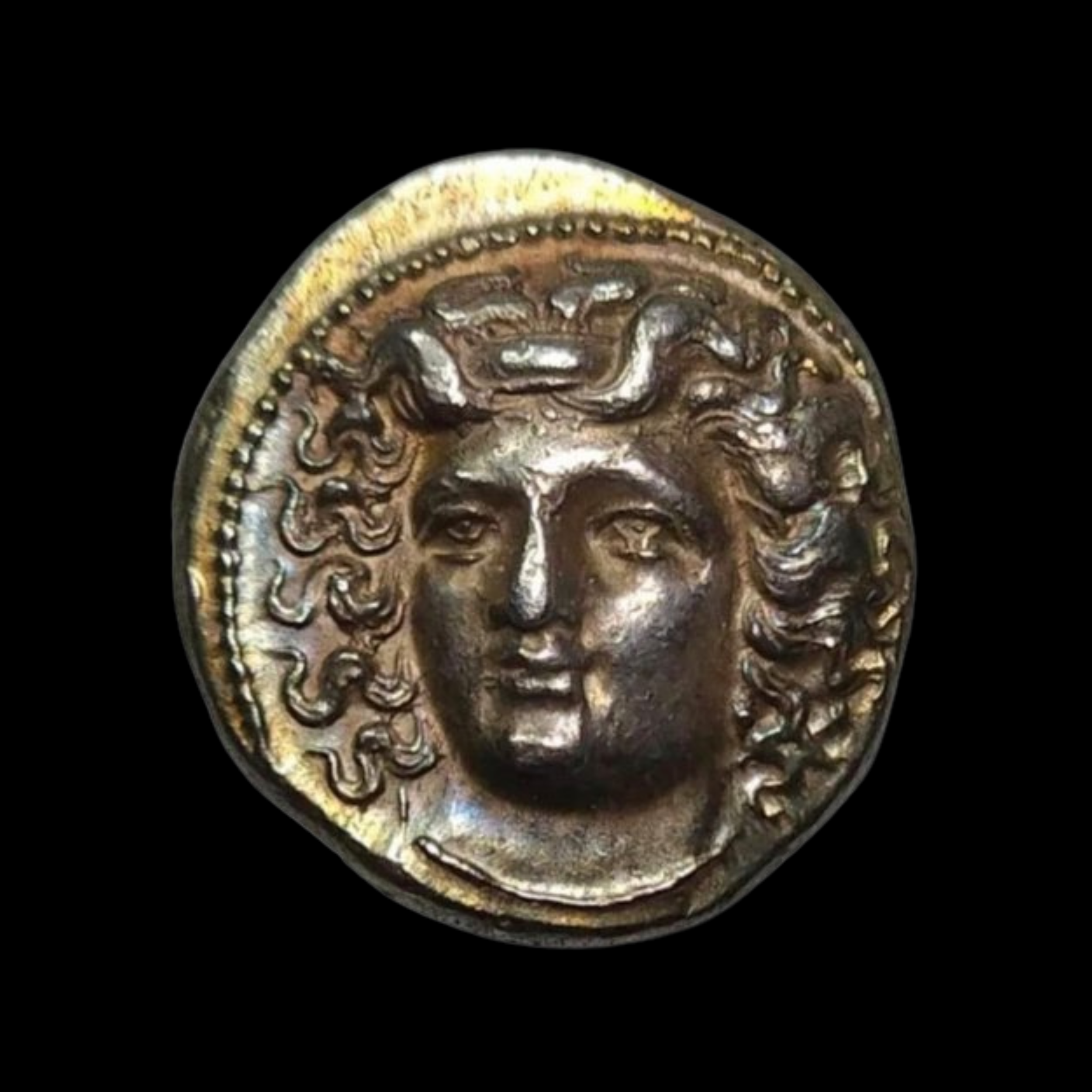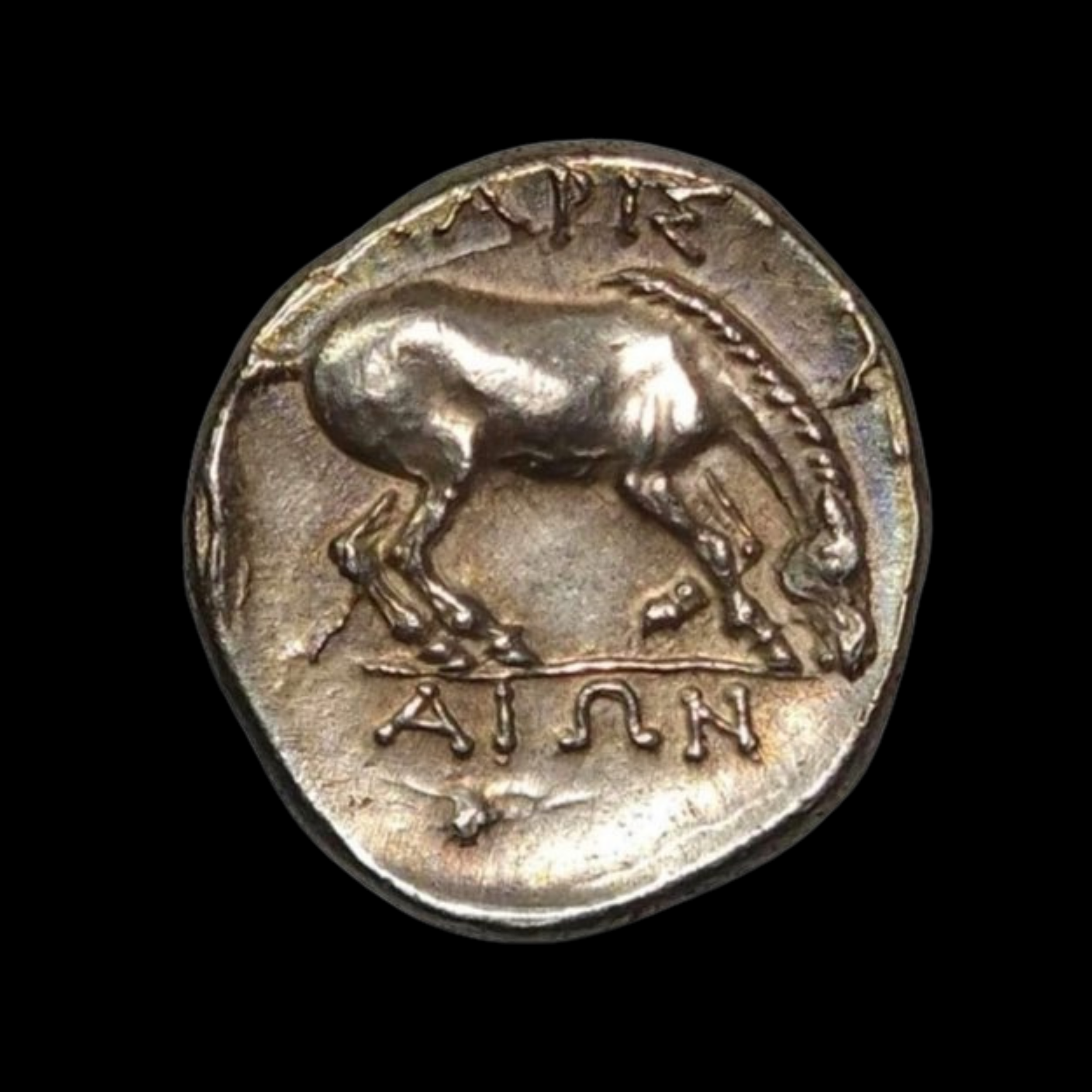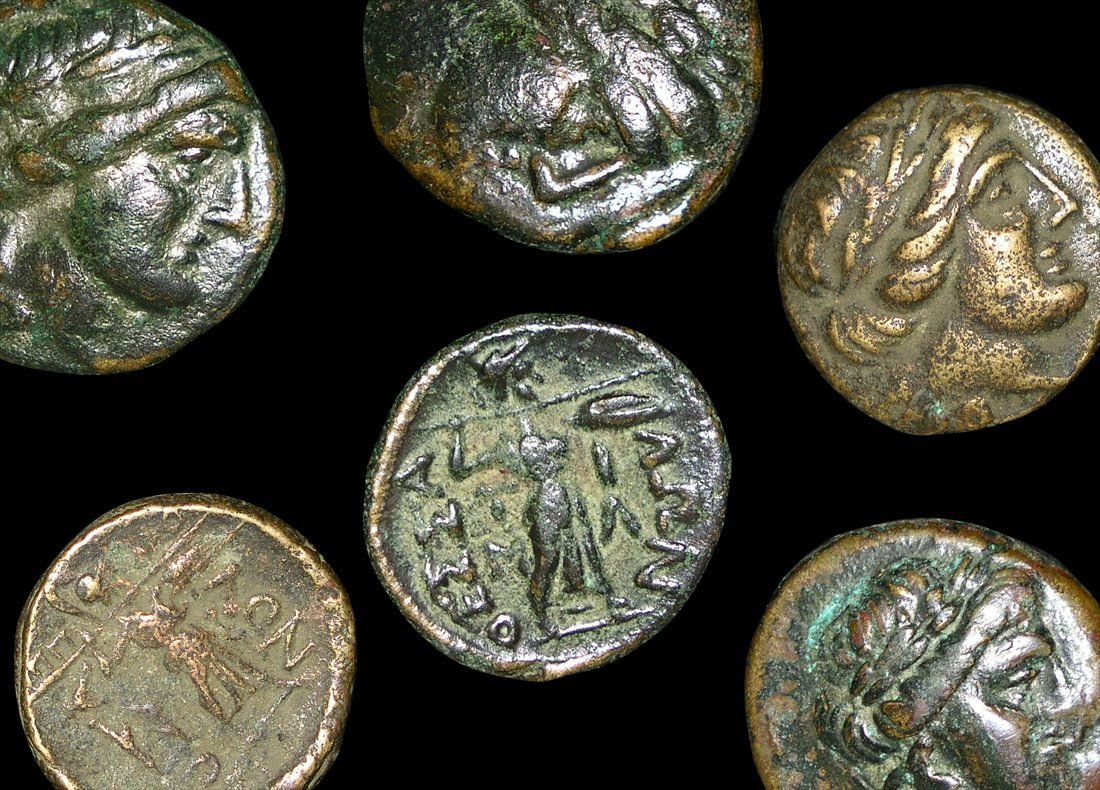 Image 1 of 2
Image 1 of 2

 Image 2 of 2
Image 2 of 2



Silver Four-Drachma Coin from Syracuse, Sicily: Made during King Agathocles' Rule (Around 2,300 Years Ago, 310-305 BCE)
This is a large silver coin called a tetradrachm, minted in the ancient Greek city of Syracuse (in present-day Sicily, Italy) during the reign of King Agathocles. Produced about 2,300 years ago, this coin reflects the city’s wealth and artistic achievements at a time when Syracuse was a major power in the Mediterranean. Agathocles ruled as both tyrant and later king, leading Syracuse through wars and political changes.
Coin Description:
Front side: The front (obverse) shows the head of the nymph Arethusa facing left. She wears a crown made of ears of corn, earrings, and a pearl necklace. Around her are three dolphins, symbolizing the sea and the city’s connection to water.
Back side: The back (reverse) features a four-horse chariot (quadriga) leaping to the left, driven by a charioteer holding the reins and a whip (kentron). Above the chariot is a triskelion, a symbol with three bent legs, and there is a line beneath (exergue line).
Technical Details:
Material composition: Silver
Denomination: Tetradrachm (equal to four drachmas, which was a standard large silver coin in the Greek world)
Catalog/reference numbers: HGCS 2 / 1348; Numista N# 49183
Certification/grade info: Examples exist in “SUP” (superb) state, with high relief and good centering
Date/period of minting: 310–305 BCE, during the reign of Agathocles
Historical Significance:
This coin was struck in Syracuse (modern Sicily, Italy) when the city was a leading Greek colony and a powerful state in the region. Under Agathocles, Syracuse fought wars against Carthage and expanded its influence, making coins like this essential for paying soldiers and conducting trade. The tetradrachm was a key part of the monetary system, widely used in commerce and recognized across the Greek world for its weight and purity, making it both a practical currency and a symbol of Syracusan power and artistry.
This is a large silver coin called a tetradrachm, minted in the ancient Greek city of Syracuse (in present-day Sicily, Italy) during the reign of King Agathocles. Produced about 2,300 years ago, this coin reflects the city’s wealth and artistic achievements at a time when Syracuse was a major power in the Mediterranean. Agathocles ruled as both tyrant and later king, leading Syracuse through wars and political changes.
Coin Description:
Front side: The front (obverse) shows the head of the nymph Arethusa facing left. She wears a crown made of ears of corn, earrings, and a pearl necklace. Around her are three dolphins, symbolizing the sea and the city’s connection to water.
Back side: The back (reverse) features a four-horse chariot (quadriga) leaping to the left, driven by a charioteer holding the reins and a whip (kentron). Above the chariot is a triskelion, a symbol with three bent legs, and there is a line beneath (exergue line).
Technical Details:
Material composition: Silver
Denomination: Tetradrachm (equal to four drachmas, which was a standard large silver coin in the Greek world)
Catalog/reference numbers: HGCS 2 / 1348; Numista N# 49183
Certification/grade info: Examples exist in “SUP” (superb) state, with high relief and good centering
Date/period of minting: 310–305 BCE, during the reign of Agathocles
Historical Significance:
This coin was struck in Syracuse (modern Sicily, Italy) when the city was a leading Greek colony and a powerful state in the region. Under Agathocles, Syracuse fought wars against Carthage and expanded its influence, making coins like this essential for paying soldiers and conducting trade. The tetradrachm was a key part of the monetary system, widely used in commerce and recognized across the Greek world for its weight and purity, making it both a practical currency and a symbol of Syracusan power and artistry.
This is a large silver coin called a tetradrachm, minted in the ancient Greek city of Syracuse (in present-day Sicily, Italy) during the reign of King Agathocles. Produced about 2,300 years ago, this coin reflects the city’s wealth and artistic achievements at a time when Syracuse was a major power in the Mediterranean. Agathocles ruled as both tyrant and later king, leading Syracuse through wars and political changes.
Coin Description:
Front side: The front (obverse) shows the head of the nymph Arethusa facing left. She wears a crown made of ears of corn, earrings, and a pearl necklace. Around her are three dolphins, symbolizing the sea and the city’s connection to water.
Back side: The back (reverse) features a four-horse chariot (quadriga) leaping to the left, driven by a charioteer holding the reins and a whip (kentron). Above the chariot is a triskelion, a symbol with three bent legs, and there is a line beneath (exergue line).
Technical Details:
Material composition: Silver
Denomination: Tetradrachm (equal to four drachmas, which was a standard large silver coin in the Greek world)
Catalog/reference numbers: HGCS 2 / 1348; Numista N# 49183
Certification/grade info: Examples exist in “SUP” (superb) state, with high relief and good centering
Date/period of minting: 310–305 BCE, during the reign of Agathocles
Historical Significance:
This coin was struck in Syracuse (modern Sicily, Italy) when the city was a leading Greek colony and a powerful state in the region. Under Agathocles, Syracuse fought wars against Carthage and expanded its influence, making coins like this essential for paying soldiers and conducting trade. The tetradrachm was a key part of the monetary system, widely used in commerce and recognized across the Greek world for its weight and purity, making it both a practical currency and a symbol of Syracusan power and artistry.
You Might Also Like











